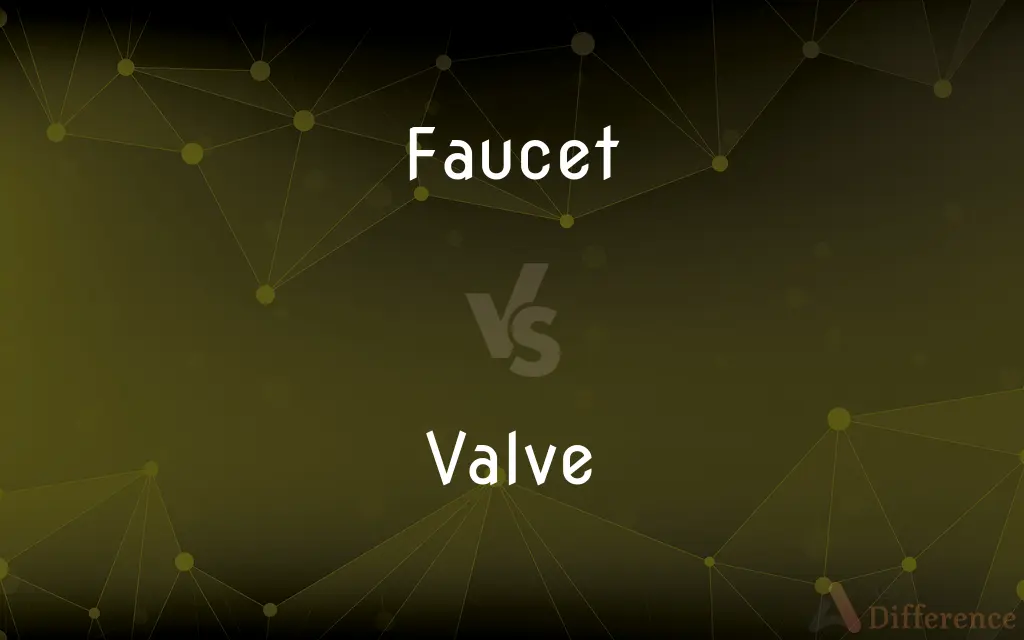Faucet vs. Valve — What's the Difference?
By Fiza Rafique & Urooj Arif — Updated on May 2, 2024
A faucet is a specific type of valve designed for controlling the release of water in settings like kitchens and bathrooms, while a valve is a broader device used to regulate the flow of any fluid or gas in pipes.

Difference Between Faucet and Valve
Table of Contents
ADVERTISEMENT
Key Differences
A faucet is specifically designed for the controlled release of water in residential, commercial, and industrial settings, allowing users to adjust both the flow and temperature of water. In contrast, a valve has a broader application, controlling the flow of various fluids and gases, not limited to water, in systems ranging from simple piping to complex industrial processes.
Faucets are typically part of everyday fixtures in sinks, showers, and tubs, featuring components like handles, spouts, and sometimes advanced features like touchless operation or water filtration. Valves, however, can be found in a myriad of forms including gate, globe, ball, and butterfly designs, each suited to specific types of flow control and pressure requirements.
The operation of a faucet is generally straightforward, designed for frequent use by the general public, with simple on and off controls, and often designed with aesthetics in mind. Valves might require specific knowledge or tools to operate, especially in industrial settings, and are more focused on functionality and durability than appearance.
In terms of installation, faucets are usually installed at points of use and are visible parts of plumbing fixtures, while valves are often part of the internal plumbing system, hidden from view and located at strategic points to control flow or pressure within the system.
Maintenance for faucets often involves cleaning and occasionally replacing washers or cartridges, whereas valve maintenance can be more complex, involving lubrication, adjustment, or replacement depending on the type of valve and its exposure to wear and tear.
ADVERTISEMENT
Comparison Chart
Primary Function
Control water release in everyday use
Regulate flow and pressure of fluids/gases
Typical Locations
Kitchens, bathrooms, gardens
Throughout plumbing and industrial systems
Types
Compression, ball, disc, cartridge
Ball, gate, globe, butterfly, check
User Operation
Designed for public use, often decorative
Often requires specific knowledge or tools
Maintenance
Generally simpler, involves cleaning
Can be complex, depending on type
Compare with Definitions
Faucet
A fixture controlling the flow of water from a plumbing system.
He turned on the faucet to wash his hands.
Valve
Can be designed to operate under high pressure.
High-pressure valves are used in hydraulic systems.
Faucet
Focuses on ease of use and accessibility.
The faucet's design was ergonomic, suitable for all ages.
Valve
A device that controls the flow of a fluid through a system.
The technician adjusted the valve to regulate the steam pressure.
Faucet
May include features like filtration systems.
Their new faucet comes with a built-in water filter.
Valve
May require periodic maintenance to function properly.
Regular maintenance on the valves ensured optimal operation.
Faucet
Can be designed to mix hot and cold water.
The kitchen faucet features a single handle that mixes hot and cold water.
Valve
Used in both residential and industrial settings.
Valves are critical components in the refinery's piping system.
Faucet
Often found in homes and public restrooms.
The public bathroom was equipped with automatic faucets.
Valve
Essential for controlling fluid dynamics.
The water distribution system used several valves to manage flow.
Faucet
A device for regulating the flow of a liquid from a reservoir such as a pipe or drum. See Note at andiron.
Valve
A valve is a device or natural object that regulates, directs or controls the flow of a fluid (gases, liquids, fluidized solids, or slurries) by opening, closing, or partially obstructing various passageways. Valves are technically fittings, but are usually discussed as a separate category.
Faucet
(North America) An exposed plumbing fitting; a tap or spigot; a regulator for controlling the flow of a liquid from a reservoir.
Valve
A device for controlling the passage of fluid or air through a pipe, duct, etc., especially an automatic device allowing movement in one direction only
A valve shuts off the flow from the boiler when the water is hot enough
Faucet
(game development) One or several systems that inject currency into the game's economy, thus controlling or preventing inflation
Valve
Each of the halves of the hinged shell of a bivalve mollusc or brachiopod, or of the parts of the compound shell of a barnacle.
Faucet
A fixture for drawing a liquid, as water, molasses, oil, etc., from a pipe, cask, or other vessel, in such quantities as may be desired; - called also tap, and cock. It consists of a tubular spout, stopped with a movable plug, spigot, valve, or slide.
Valve
Any of various devices that regulate the flow of gases, liquids, or loose materials through piping or through apertures by opening, closing, or obstructing ports or passageways.
Faucet
The enlarged end of a section of pipe which receives the spigot end of the next section.
Valve
The movable control element of such a device.
Faucet
A regulator for controlling the flow of a liquid from a reservoir
Valve
A device in a brass wind instrument that can be opened or closed to change the pitch by altering the length of the air column in the tube.
Valve
(Anatomy) A membranous structure in a hollow organ or passage, as in an artery or vein, that folds or closes to prevent the return flow of the body fluid passing through it.
Valve
A piece of shell covering or enclosing certain mollusks or other invertebrates, especially the single one of a univalve mollusk or one of the paired hinged ones of a bivalve mollusk or brachiopod.
Valve
One of the two siliceous halves of the cell wall of a diatom.
Valve
One of the pieces into which a plant part splits at maturity, especially a segment of a fruit capsule or of certain anthers.
Valve
Chiefly British An electron tube or a vacuum tube.
Valve
(Archaic) Either half of a double or folding door.
Valve
To provide with a valve.
Valve
To control by means of a valve.
Valve
A device that controls the flow of a gas or fluid through a pipe.
Shut off the valve
Open the valve
Valve
A device that admits fuel and air into the cylinder of an internal combustion engine, or one that allows combustion gases to exit.
Valve
(anatomy) One or more membranous partitions, flaps, or folds, which permit the passage of the contents of a vessel or cavity in one direction, but stop or control the flow in the opposite direction
The ileocolic, mitral, and semilunar valves
Valve
One of the leaves of a folding-door, or a window-sash.
Valve
(British) A vacuum tube.
Valve
(botany) One of the pieces into which certain fruits naturally separate when they dehisce.
Valve
(botany) A small portion of certain anthers, which opens like a trapdoor to allow the pollen to escape, such as in the barberry.
Valve
(biology) One of the pieces or divisions of bivalve or multivalve shells.
Valve
(biology) One of the two similar portions of the shell of a diatom.
Valve
(transitive) To control (flow) by means of a valve.
Valve
A door; especially, one of a pair of folding doors, or one of the leaves of such a door.
Swift through the valves the visionary fairRepassed.
Heavily closed, . . . the valves of the barn doors.
Valve
A lid, plug, or cover, applied to an aperture so that by its movement, as by swinging, lifting and falling, sliding, turning, or the like, it will open or close the aperture to permit or prevent passage, as of a fluid.
Valve
One or more membranous partitions, flaps, or folds, which permit the passage of the contents of a vessel or cavity in one direction, but stop or retard the flow in the opposite direction; as, the ileocolic, mitral, and semilunar valves.
Valve
One of the pieces into which a capsule naturally separates when it bursts.
Valve
One of the pieces or divisions of bivalve or multivalve shells.
Valve
A structure in a hollow organ (like the heart) with a flap to insure one-way flow of fluid through it
Valve
Device in a brass wind instrument for varying the length of the air column to alter the pitch of a tone
Valve
Control consisting of a mechanical device for controlling the flow of a fluid
Common Curiosities
What is a valve?
A valve is a device used to control the flow and pressure of fluids and gases within a system.
How do I maintain a valve?
Maintenance can vary significantly but often includes lubrication, cleaning, and periodic inspection and replacement.
What types of valves are there?
Common types include ball, gate, globe, butterfly, and check valves.
Can a faucet be considered a type of valve?
Yes, a faucet is a specific type of valve designed primarily for water control.
Where are valves used?
Valves are used throughout various systems, including plumbing, oil and gas, water distribution, and industrial processes.
Are all faucets manual?
No, some modern faucets operate electronically or even touchlessly to provide convenience and hygiene.
How do I maintain a faucet?
Maintenance typically involves cleaning and replacing parts like washers or cartridges when they wear out.
What is a faucet?
A faucet is a device designed to control the release of water in residential, commercial, and public settings.
Do valves affect water pressure?
Yes, valves can be used to adjust the pressure of water or any fluid within a system.
Can a malfunctioning faucet affect my home's plumbing?
Yes, a malfunctioning faucet can lead to leaks or water damage, affecting your home's plumbing integrity.
Where are faucets commonly used?
Faucets are commonly used in settings such as kitchens, bathrooms, and gardens.
Are there specialized faucets for different uses?
Yes, there are faucets designed for specific uses, including those with filtration systems, different handle types for temperature control, and those intended for utility sinks or showers.
What should I consider when installing a valve?
Consider the type of fluid or gas, pressure requirements, and the specific function the valve needs to perform within the system.
What is the difference between a faucet and a spigot?
The terms are often used interchangeably, but "spigot" typically refers to an outdoor fixture, while "faucet" is more commonly used for indoor water fixtures.
How can I tell if a valve is failing?
Signs of a failing valve include leaks, noises, or a failure to properly control flow or pressure.
Share Your Discovery

Previous Comparison
Aboriginal vs. Indigenous
Next Comparison
Glyptal vs. DacronAuthor Spotlight
Written by
Fiza RafiqueFiza Rafique is a skilled content writer at AskDifference.com, where she meticulously refines and enhances written pieces. Drawing from her vast editorial expertise, Fiza ensures clarity, accuracy, and precision in every article. Passionate about language, she continually seeks to elevate the quality of content for readers worldwide.
Co-written by
Urooj ArifUrooj is a skilled content writer at Ask Difference, known for her exceptional ability to simplify complex topics into engaging and informative content. With a passion for research and a flair for clear, concise writing, she consistently delivers articles that resonate with our diverse audience.
















































